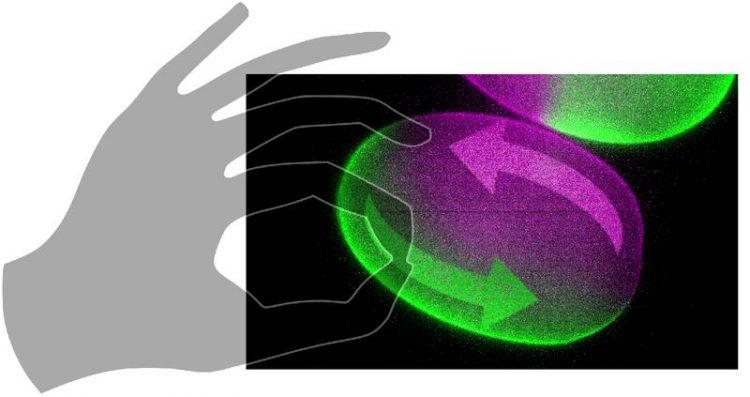FLUCS – An interactive microscope for biologists

Researchers generate flows in early embryos to guide organism development. Mittasch et.al. / MPI-CBG
A central question in biology is how entire organisms develop from single fertilized eggs. And although genetic research has revealed deep insights into this enigmatic subject in recent years, one particular aspect of development remained elusive. For an organism to develop a structured body, biomolecules need to move to specific sites inside the embryo, similar to building material on a construction site.
A particularly important example for this distribution of material inside cells is the polarization of an embryo, which defines where the head and tail of a worm will grow. But until now, it has remained controversial which transport mechanisms define this head-tail polarization so precisely, because it was not possible to move the inside of an embryo without harming it.
A team of researchers around Moritz Kreysing in collaboration with other groups at MPI-CBG, as well as the Faculty of Mathematics and the Biotechnology Center, both of the TU Dresden, has now succeeded in inducing controlled flows in living embryos with a non-invasive laser technology called FLUCS (focused-light-induced-cytoplasmic-streaming). With this truly revolutionary tool at hand (see figure), the researchers were able to probe the function of cytoplasmic motion in the process of embryo polarization.
Matthäus Mittasch, the leading author of the study says: “With FLUCS, microscopy of growing embryos becomes truly interactive”. And indeed: with the help of realistic computer simulations the researchers even managed to reverse the head-to-tail body axis of worm embryos with FLUCS, leading to inverted development.
Lead investigator Moritz Kreysing, with a dual affiliation to the Center for Systems Biology Dresden, concludes: “The ability to actively move the interior of biological cells will help to understand how these cells change shape, how they move, divide, respond to external signals, and ultimately how entire organisms emerge guided by microscale motion.” On the medical side, FLUCS has the potential to improve our understanding of developmental defects, aid in-vitro fertilization, organism cloning, and the discovery of new drugs.
Original Publication:
“Non-invasive perturbations of intracellular flow reveal physical principles of cell organization.” Matthäus Mittasch, Peter Groß, Michael Nestler, Anatol W. Fritsch, Christiane Iserman, Mrityunjoy Kar, Matthias Munder, Axel Voigt, Simon Alberti, Stephan W. Grill, and Moritz Kreysing: Nature Cell Biology, 20(3), 2018. https://dx.doi.org/10.1038/s41556-017-0032-9
About the MPI-CBG
The Max Planck Institute of Molecular Cell Biology and Genetics (MPI-CBG) is one of 84 institutes of the Max Planck Society, an independent, non-profit organization in Germany. 500 curiosity-driven scientists from over 50 countries ask: How do cells form tissues? The basic research programs of the MPI-CBG span multiple scales of magnitude, from molecular assemblies to organelles, cells, tissues, organs, and organisms.
http://www.mpi-cbg.de
https://www.mpi-cbg.de/en/research-groups/current-groups/moritz-kreysing/researc…
Media Contact
All latest news from the category: Life Sciences and Chemistry
Articles and reports from the Life Sciences and chemistry area deal with applied and basic research into modern biology, chemistry and human medicine.
Valuable information can be found on a range of life sciences fields including bacteriology, biochemistry, bionics, bioinformatics, biophysics, biotechnology, genetics, geobotany, human biology, marine biology, microbiology, molecular biology, cellular biology, zoology, bioinorganic chemistry, microchemistry and environmental chemistry.
Newest articles

Properties of new materials for microchips
… can now be measured well. Reseachers of Delft University of Technology demonstrated measuring performance properties of ultrathin silicon membranes. Making ever smaller and more powerful chips requires new ultrathin…

Floating solar’s potential
… to support sustainable development by addressing climate, water, and energy goals holistically. A new study published this week in Nature Energy raises the potential for floating solar photovoltaics (FPV)…

Skyrmions move at record speeds
… a step towards the computing of the future. An international research team led by scientists from the CNRS1 has discovered that the magnetic nanobubbles2 known as skyrmions can be…





















